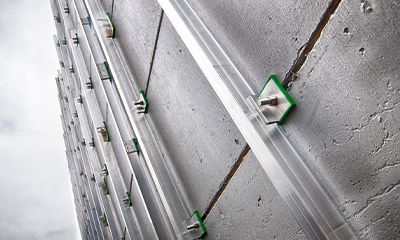Written by Hitesh Pattni (North) and Neil Kirwan (South) - Specification Managers in SFS Group Fastening Technology Ltd.
Contents:
The role of the building envelope today is, essentially, exactly the same as it was when people first sought shelter.
All of these factors serve to increase the choice of available solutions. They also make it harder to strike a balance of performance through the 'right' combination of choices. Meeting today's performance challenges is hard enough for designers and specifiers, without also thinking about making the building fit for the future - both of which contribute to a specification being robust.
This paper focuses on two significant areas of building envelope specification. It addresses thermal performance, and considers why simply adding more and more insulation may not be the way to achieve a robust specification.
The more thoughtful use of materials is also a key aspect of delivering sustainable building construction projects. If we are to meet long-term goals in the built environment then our thinking needs to switch to being longer-term. What does that look like, and how can we manufacturers help you to optimise specifications?
All of this builds on the issues described in our first four robust specification papers, and complements the other building performance criteria discussed in the sixth and seventh papers in the series.
It reinforces the benefits of creating robust specifications that aim to eliminate performance gaps. It lends weight to the idea of welcoming greater client input. And it serves as a reminder why getting product experts - manufacturers - involved earlier is key.
When discussing thermal performance, fundamentally we mean limiting the movement of heat energy between a building's conditioned interior and the external climate.
In northern European climates, that means preventing heat loss from the building to the outside for most of the year. In warmer climates, it means protecting the interior excess heat gains. This performance, or 'energy efficiency', is largely a matter of undertaking appropriate building physics calculations. It is heavily reliant on the specification of thermal insulation as part of the building envelope.
As we grapple with a changing climate, where extreme weather is more frequent and more severe, is 'thermal performance' or 'energy efficiency' a sufficient any longer? National building regulations set out calculation methods to establish appropriate U-values, but the regulatory requirements are not set with future climatic conditions in mind.
In-keeping with the definition we offered in the first paper of this series (where we said robust specification helps a building be fit for the future), is it therefore enough to design only to building regulation standards?
There is an obvious trend for achieving lower U-values, which requires thicker insulation. But not only does the building envelope have to achieve its target U-values, it must be capable of resisting frequent extreme weather to deliver those U-values - and long-term comfort - reliably.
U-value targets must therefore be realistic. They should be set to prioritise comfort, while also acknowledging that ever-thicker thermal insulation layers achieve diminishing returns. Thermal transmittance is not linear, and you have to add greater amounts of insulation to achieve smaller gains in U-values.
Increased insulation thickness have knock-on effects for the rest of the building envelope, such as increasing the depth of fasteners and the length of cladding brackets. Costs can quickly begin to spiral in the name of achieving a marginally lower U-value, so obtaining advice about the benefits and drawback of more insulation is essential.
Thicker building envelope solutions put greater pressure on the building footprint. If the space isn't available to accommodate the extra insulation, then internal floor space, whether to achieve the highest commercial rental yields or to sell residential apartments at a premium.
Buildings that achieve better 'performance' - or, to be more accurate, 'resilience' - will be well-placed to command their value further into the future. 'Stranded assets' are a genuine concern for building owners and operators. Climate change risks buildings becoming unlivable or unusable, with the cost of retrofitting them to being too high to justify.
Taking all of this into consideration, what are the priorities for calculating U-values? Accuracy is key. It's possible to establish ballpark figures for building envelope specifications, but they often make assumptions about the choice of brackets and fixings that bear no relation to the final specification.
As insulation thickness increase, the point thermal bridging effect of brackets becomes more pronounced, leading to thicker insulation, which makes the thermal bridging effect even worse. It's easy to see how a vicious circle like this can soon derail specifications when they're only looked at in detail later in the project.
Particularly for very low U-values, getting appropriate guidance on bracket types and materials (aluminum? stainless steel?) in the early stages will help to guide setting out decisions. Those decisions shape the internal floor areas and long-term building comfort that can be achieved, so dealing with them from the outset significantly reduces the possibility of performance gaps.
Accurate, early technical design sets the tone for the project. Whether the end goal is 'just' regulatory compliance, or a building resilient for the climate in the year 2100, knowing that the thermal performance or energy efficiency of the building envelope has been set accordingly makes it harder to change later on.
Installers often review specifications purely on a 'cost per item' basis, and will seek to change individual components, with limited awareness of how they contribute to the complete system. Understanding that every element of the building specification has been specified with a certain performance in mind makes it much easier to 'defend' that specification against cost engineering exercises.
Robust Building Envelope Specifications
Paper 5: Thermal performance and sustainability
Contents:
- Introduction: building envelope performance
- Thermal performance: what is it?
- Thermal performance: is thicker insulation the answer?
- Thermal performance: using early engagement to build resiliently
- Sustainability: the impact of human activity
- Sustainability: whole life impacts
- Sustainability: thinking beyond carbon emissions through early engagement
- SFS robust specification series
- About SFS Construction UK.
Building envelope performance
The role of the building envelope today is, essentially, exactly the same as it was when people first sought shelter.
- Provide protection from the elements
- Offer a view to the outside
- Give occupants security
- Achieve a level of comfort inside compared to outside
- Higher standards and greater expectations
- Compliance with compulsory regulations and voluntary standards
- Globalised supply chains capable of offering hundreds of different types of products
All of these factors serve to increase the choice of available solutions. They also make it harder to strike a balance of performance through the 'right' combination of choices. Meeting today's performance challenges is hard enough for designers and specifiers, without also thinking about making the building fit for the future - both of which contribute to a specification being robust.
This paper focuses on two significant areas of building envelope specification. It addresses thermal performance, and considers why simply adding more and more insulation may not be the way to achieve a robust specification.
The more thoughtful use of materials is also a key aspect of delivering sustainable building construction projects. If we are to meet long-term goals in the built environment then our thinking needs to switch to being longer-term. What does that look like, and how can we manufacturers help you to optimise specifications?
All of this builds on the issues described in our first four robust specification papers, and complements the other building performance criteria discussed in the sixth and seventh papers in the series.
It reinforces the benefits of creating robust specifications that aim to eliminate performance gaps. It lends weight to the idea of welcoming greater client input. And it serves as a reminder why getting product experts - manufacturers - involved earlier is key.
Thermal Performance: what is it?
When discussing thermal performance, fundamentally we mean limiting the movement of heat energy between a building's conditioned interior and the external climate.
In northern European climates, that means preventing heat loss from the building to the outside for most of the year. In warmer climates, it means protecting the interior excess heat gains. This performance, or 'energy efficiency', is largely a matter of undertaking appropriate building physics calculations. It is heavily reliant on the specification of thermal insulation as part of the building envelope.
As we grapple with a changing climate, where extreme weather is more frequent and more severe, is 'thermal performance' or 'energy efficiency' a sufficient any longer? National building regulations set out calculation methods to establish appropriate U-values, but the regulatory requirements are not set with future climatic conditions in mind.
In-keeping with the definition we offered in the first paper of this series (where we said robust specification helps a building be fit for the future), is it therefore enough to design only to building regulation standards?
Thermal Performance: is thicker insulation the answer?
There is an obvious trend for achieving lower U-values, which requires thicker insulation. But not only does the building envelope have to achieve its target U-values, it must be capable of resisting frequent extreme weather to deliver those U-values - and long-term comfort - reliably.
U-value targets must therefore be realistic. They should be set to prioritise comfort, while also acknowledging that ever-thicker thermal insulation layers achieve diminishing returns. Thermal transmittance is not linear, and you have to add greater amounts of insulation to achieve smaller gains in U-values.
Increased insulation thickness have knock-on effects for the rest of the building envelope, such as increasing the depth of fasteners and the length of cladding brackets. Costs can quickly begin to spiral in the name of achieving a marginally lower U-value, so obtaining advice about the benefits and drawback of more insulation is essential.
Thicker building envelope solutions put greater pressure on the building footprint. If the space isn't available to accommodate the extra insulation, then internal floor space, whether to achieve the highest commercial rental yields or to sell residential apartments at a premium.
Thermal Performance: using early engagement to build resiliently
Buildings that achieve better 'performance' - or, to be more accurate, 'resilience' - will be well-placed to command their value further into the future. 'Stranded assets' are a genuine concern for building owners and operators. Climate change risks buildings becoming unlivable or unusable, with the cost of retrofitting them to being too high to justify.
Taking all of this into consideration, what are the priorities for calculating U-values? Accuracy is key. It's possible to establish ballpark figures for building envelope specifications, but they often make assumptions about the choice of brackets and fixings that bear no relation to the final specification.
As insulation thickness increase, the point thermal bridging effect of brackets becomes more pronounced, leading to thicker insulation, which makes the thermal bridging effect even worse. It's easy to see how a vicious circle like this can soon derail specifications when they're only looked at in detail later in the project.
Particularly for very low U-values, getting appropriate guidance on bracket types and materials (aluminum? stainless steel?) in the early stages will help to guide setting out decisions. Those decisions shape the internal floor areas and long-term building comfort that can be achieved, so dealing with them from the outset significantly reduces the possibility of performance gaps.
Accurate, early technical design sets the tone for the project. Whether the end goal is 'just' regulatory compliance, or a building resilient for the climate in the year 2100, knowing that the thermal performance or energy efficiency of the building envelope has been set accordingly makes it harder to change later on.
Installers often review specifications purely on a 'cost per item' basis, and will seek to change individual components, with limited awareness of how they contribute to the complete system. Understanding that every element of the building specification has been specified with a certain performance in mind makes it much easier to 'defend' that specification against cost engineering exercises.
Sustainability: the impact of human activity
Human activity has an environment impact, and nowhere is that truer than in the construction industry. The UK construction industry alone uses around 400 million tonnes of materials every year, with around a quarter of that becoming waste.
As global populations continue to grow and become more urbanised, the worldwide demand for raw materials will increase and put further pressure on diminishing finite resources.
How do we reconcile our ongoing need for buildings with the environmental impact that construction activity has on the planet? Efficiency is key, and it is a concept that can be applied at all stages of projects. It starts with asking whether new construction is necessary, or can a client's needs be met using an existing asset?
If a new building is required, how can it be designed to use resources efficiently and to avoid waste? How can it be delivered efficiently on site? This means thinking about cost, operation and maintenance, and what will happen to the building at the end of its life.
As global populations continue to grow and become more urbanised, the worldwide demand for raw materials will increase and put further pressure on diminishing finite resources.
How do we reconcile our ongoing need for buildings with the environmental impact that construction activity has on the planet? Efficiency is key, and it is a concept that can be applied at all stages of projects. It starts with asking whether new construction is necessary, or can a client's needs be met using an existing asset?
If a new building is required, how can it be designed to use resources efficiently and to avoid waste? How can it be delivered efficiently on site? This means thinking about cost, operation and maintenance, and what will happen to the building at the end of its life.

Sustainability: whole life impacts
There is a lot of discussion with the construction industry about embodied carbon. Reductions in embodied carbon can mean a project is using resources more efficiently simply by using less of them. In the context of the linear economy, however, where materials and products are still routinely disposed of at the end of their life, is embodied carbon the right long-term metric?
By looking at materials and products in terms of their whole life impact, we can start to shift the construction industry towards a circular economy approach that it's vital the built environment embraces.
The availability of environmental product declarations (EPDs) supports this. When manufacturers can supply EPDs that report on all circular impacts, specificers are better placed to make informed decisions.
Metals such as steel and aluminium have a high embodied carbon, but we can think about how to design with them in a way that takes advantage of their strength and durability. Designing components for reuse means that when a building reaches the end of its useful life, it can be disassembled and the components used on a new site. Demand for raw materials and new products is reduced. And even though these metals are infinitely recyclable, the environment impact associated with the recycling process is avoided too.
Sustainability: thinking beyond carbon emissions through early engagement
This kind of thinking means having information available to understand products in a different way, and that is a key area in which specifiers and manufacturers can work together.
It means knowing more about where raw materials are sourced from and how far they have travelled to be made into a construction product, and then delivered to site. It means having an understanding of how components perform in use, how they contribute to the overall performance of the building. It means knowing where to obtain information about what to do with a product at the end of the building's life.
Current building regulations do not include requirements for these aspects of building design and specification. They might do so in the future, but for now the focus of regulations is on the operational efficiency of buildings, including the U-values discussed earlier in the document.
Important as that is, there is a lot more to sustainability.
The transition away from fossil fuels means designing buildings with high levels of building fabric performance and efficiency specified renewable technology. Engaging with manufacturers means specifiers can work to design a building envelope that is capable of incorporating those renewables as part of the system, thereby achieving long-term sustainability.
SFS robust specification series
This paper is one of a series exploring different areas relating to building envelope specification, and looking at the performance criteria that must come together in order to meet the clients needs.
- Defining robust specification
- The problem of performance gaps
- Getting clients active and engaged
- Early engagement: how do we get more of it?
- Thermal performance and sustainability
- Fire safety
- Corrosion, warranties and supply chain challenges
Ultimately, we want to show why and how prioritising early engagement on construction projects can lead to better building envelope specifications. Specifications that are robust, and which are the best for the individual project.
It's no exaggeration that specifiers face a more complex and evolving landscape than ever before. Throughout these documents, we'll show why the benefits of early specification, based on technical expertise provided by external parties, can far outweigh any potential drawbacks.
More Information
Find out more on how SFS UK are working to reduce waste, being more energy efficient and creating a more sustainable future for all by visiting our Sustainability Page here.
FAQs
What is thermal performance of a building?
Thermal performance: The Thermal Performance for a building is defined as the average energy expenditure required to warm and cool the interior of the building to the minimum temperature level.
How is thermal performance measured?
Thermal performance measures its loss, and is typically expressed in the construction industry by U-value and R-value. U-value calculation is inevitably necessary in the creation of construction strategies. U values represent thermal transmittance per given area and are measured in W/m2K.
What makes up the building envelope?
The building envelope include all the building components that separate the indoors from the outdoors. Building envelopes include the exterior walls, foundations, roof, windows, and doors.

 English (Canada)
English (Canada)
 čeština (Česká republika)
čeština (Česká republika)
 magyar (Magyarország)
magyar (Magyarország)
 Deutsch (Deutschland)
Deutsch (Deutschland)
 eesti (Eesti)
eesti (Eesti)
 español (España)
español (España)
 português (Portugal)
português (Portugal)
 English
English
 suomi (Suomi)
suomi (Suomi)
 français (France)
français (France)
 italiano (Italia)
italiano (Italia)
 Nederlands (Nederland)
Nederlands (Nederland)
 norsk, bokmål (Norge)
norsk, bokmål (Norge)
 polski (Polska)
polski (Polska)
 svenska (Sverige)
svenska (Sverige)
 Türkçe (Türkiye)
Türkçe (Türkiye)




